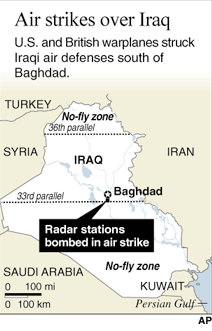 Isle military forces not involved in attack Isle military forces not involved in attack
By Robert Burns
AP Military Writer
WASHINGTON — The joint U.S.-British air strike against Iraq, described by President Bush as routine, was the biggest blow against Saddam Hussein's military in more than two years and involved two dozen attack planes armed with precision-guided missiles, Pentagon officials say.
"A routine mission was conducted to enforce the 'no-fly' zone'' over southern Iraq, Bush said yesterday. "It was a mission about which I was informed and I authorized. But I repeat, it's a routine mission.''
It was the first military action ordered by the new president, who inherited an Iraq policy that has evolved from the 1991 Persian Gulf War that his father carried out to evict the Iraqi army from Kuwait. A key part of that policy is enforcement of no-fly zones over northern and southern Iraq — a mission that has taxed the U.S. military while also taking a heavy toll on Iraq's extensive air defenses.
Iraq does not accept the legitimacy of the no-fly zones. Iraqi television said one person was killed and 11 injured in yesterday's attack.
Bush was in Mexico meeting with President Vicente Fox at the time the missiles were launched at about 7:30 a.m. Hawai'i time. White House spokesman Ari Fleischer said Bush gave the go-ahead on Thursday.
At the Pentagon, Marine Lt. Gen. Gregory Newbold, director of operations for the Joint Chiefs of Staff, called the strike a "self-defense measure'' initiated by the commander of U.S. forces in the Persian Gulf. The number of U.S. and British attack planes involved — 24 — was much larger than in previous missions over northern and southern Iraq in recent years.
Dozens of support aircraft also were involved, including electronic jamming and radar control planes.
Bush's approval was required, Newbold said, because the mission was not the usual small-scale attack that U.S. and British pilots have carried out almost routinely inside the no-fly zones. It was the first strike at targets outside the southern flight-restriction zone since December 1998, officials said.
The Pentagon said five targets were struck, including long-range surveillance radars and associated facilities that Iraq has used more frequently over the past six weeks to coordinate its defenses against U.S. and British patrols. The radars allow Iraq to make better use of its surface-to-air missiles.
The U.S. Central Command said Iraq recently increased its use of anti-aircraft artillery and surface-to-air missiles, with more than 60 incidents since Jan. 1. It gave no figures for previous periods.
Asked whether the attack was a signal to Iraqi President Saddam Hussein that the new administration would take more frequent and more forceful military action, Bush said, "Saddam Hussein has got to understand that we expect him to conform to the agreement that he signed'' after the 1991 Gulf War.
Iraq has not followed the requirements set down in cease-fire resolutions that were designed to ensure it not develop long-range ballistic missiles or nuclear weapons.
Bush said Saddam and his nation must not try to acquire or build weapons of mass destruction. "If we catch him doing so, we'll take appropriate action,'' the president said. Yesterday's attack, however, appeared largely unrelated to Iraq's bomb-building ambitions but rather a new chapter in the long-running battle over no-fly zones.
The United States, with British and French support, established the southern zone as a means of preventing Iraqi forces from attacking Shiite rebels. The northern zone was meant to protect minority Kurds, whose uprising after the Gulf War was crushed by the Iraqi army.
"We will enforce the no-fly zone, both south and north,'' Bush said. "Our intention is to make sure the world is as peaceful as possible.''
Condoleezza Rice, the president's national security adviser, told reporters traveling with Bush in Mexico that the administration was continuing the Clinton administration's policy of striking at Iraqi air defenses.
"There isn't any change in policy,'' she said.
In addition to land-based Air Force F-15E Strike Eagles and Navy F/A-18 Hornets from the aircraft carrier USS Harry S. Truman in the Persian Gulf, there were many other command, control and other support planes involved in Friday's action, Pentagon officials said. They declined to provide full details.
In London, Defense Secretary Geoffrey Hoon said the attacks were a "proportionate response'' to an increased threat to patrolling aircraft.
[back to top] |

